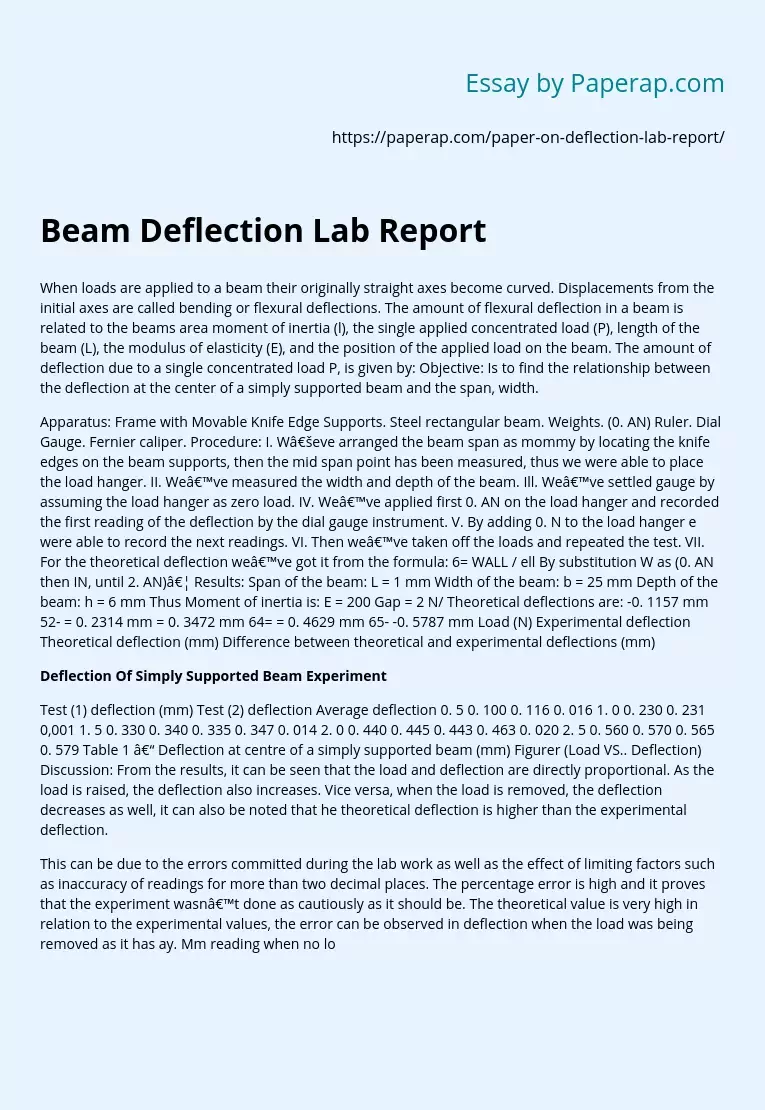Beam Deflection Lab Report
When loads are applied to a beam their originally straight axes become curved. Displacements from the initial axes are called bending or flexural deflections. The amount of flexural deflection in a beam is related to the beams area moment of inertia (l), the single applied concentrated load (P), length of the beam (L), the modulus of elasticity (E), and the position of the applied load on the beam. The amount of deflection due to a single concentrated load P, is given by: Objective: Is to find the relationship between the deflection at the center of a simply supported beam and the span, width.
Apparatus: Frame with Movable Knife Edge Supports. Steel rectangular beam. Weights. (0. AN) Ruler. Dial Gauge. Fernier caliper. Procedure: I. W‚eve arranged the beam span as mommy by locating the knife edges on the beam supports, then the mid span point has been measured, thus we were able to place the load hanger. II. We’ve measured the width and depth of the beam.
Ill. We’ve settled gauge by assuming the load hanger as zero load. IV. We’ve applied first 0. AN on the load hanger and recorded the first reading of the deflection by the dial gauge instrument. V. By adding 0. N to the load hanger e were able to record the next readings. VI. Then we’ve taken off the loads and repeated the test. VII. For the theoretical deflection we’ve got it from the formula: 6= WALL / ell By substitution W as (0. AN then IN, until 2.
AN)… Results: Span of the beam: L = 1 mm Width of the beam: b = 25 mm Depth of the beam: h = 6 mm Thus Moment of inertia is: E = 200 Gap = 2 N/ Theoretical deflections are: -0. 1157 mm 52- = 0. 2314 mm = 0. 3472 mm 64= = 0. 4629 mm 65- -0. 5787 mm Load (N) Experimental deflection Theoretical deflection (mm) Difference between theoretical and experimental deflections (mm)
Deflection Of Simply Supported Beam Experiment
Test (1) deflection (mm) Test (2) deflection Average deflection 0. 5 0. 100 0. 116 0. 016 1. 0 0. 230 0. 231 0,001 1. 5 0. 330 0. 340 0. 335 0. 347 0. 014 2. 0 0. 440 0. 445 0. 443 0. 463 0. 020 2. 5 0. 560 0. 570 0. 565 0. 579 Table 1 – Deflection at centre of a simply supported beam (mm) Figurer (Load VS.. Deflection) Discussion: From the results, it can be seen that the load and deflection are directly proportional. As the load is raised, the deflection also increases. Vice versa, when the load is removed, the deflection decreases as well, it can also be noted that he theoretical deflection is higher than the experimental deflection.
This can be due to the errors committed during the lab work as well as the effect of limiting factors such as inaccuracy of readings for more than two decimal places. The percentage error is high and it proves that the experiment wasn’t done as cautiously as it should be. The theoretical value is very high in relation to the experimental values, the error can be observed in deflection when the load was being removed as it has ay. Mm reading when no load is placed. This could be due to the zero error which means that the arrow was not placed to zero before he experiment began or it could be due to some defects in the apparatus.
It could also be due to air pressure. Conclusion: The conclusion to this report is that the deflection and load are directly proportional and deflection increases as greater load is placed on the beam. The slope of the graph is steep and it increases sharply when the load is placed in mid-span. Errors can never be ignored when it comes to laboratory work. The aim is to reduce the error as much as possible to obtain accuracy in work. Ways to reduce the error are: By repeating the experiment for three times or more and then taking the average readings.
By being extra cautious during the experiment… By asking more than one person to record the readings and carry out the experiment… By using digital gauge indicator to record the experimental values. References: Mechanics of Materials, Russell C. Hobbler Experimental methods: an introduction to the analysis and presentation of data, By Less Kirk Mechanics of Materials (8th De. ), By Greer, James M. , Good, Barry J. Materials Science and Engineering an Introduction (4th De. ), William D Cloister, JAR (Frank Durra and Hosannas al Imagine, 2003)
Beam Deflection Lab Report. (2019, Dec 05). Retrieved from https://paperap.com/paper-on-deflection-lab-report/

